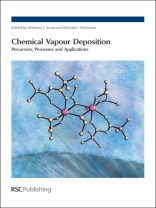Chemical Vapour Deposition (CVD) involves the deposition of thin solid films from chemical precursors in the vapour phase, and encompasses a variety of deposition techniques, including a range of thermal processes, plasma enhanced CVD (PECVD), photon- initiated CVD, and atomic layer deposition (ALD). The development of CVD technology owes a great deal to collaboration between different scientific disciplines such as chemistry, physics, materials science, engineering and microelectronics, and the publication of this book will promote and stimulate continued dialogue between scientists from these different research areas. The book is one of the most comprehensive overviews ever written on the key aspects of chemical vapour deposition processes and it is more comprehensive, technically detailed and up-to-date than other books on CVD. The contributing authors are all practising CVD technologists and are leading international experts in the field of CVD. It presents a logical and progressive overview of the various aspects of CVD processes. Basic concepts, such as the various types of CVD processes, the design of CVD reactors, reaction modelling and CVD precursor chemistry are covered in the first few chapters. Then follows a detailed description of the use of a variety CVD techniques to deposit a wide range of materials, including semiconductors, metals, metal oxides and nitrides, protective coatings and functional coatings on glass. Finally and uniquely, for a technical volume, industrial and commercial aspects of CVD are also discussed together with possible future trends, which is an unusual, but very important aspect of the book. The book has been written with CVD practitioners in mind, such as the chemist who wishes to learn more about CVD processes, or the CVD technologist who wishes to gain an increased knowledge of precursor chemistry. The volume will prove particularly useful to those who have recently entered the field, and it will also make a valuable contribution to chemistry and materials science lecture courses at undergraduate and postgraduate level.
Jadual kandungan
An overview of CVD processes CVD reactors and delivery systems Modeling CVD processes ALD processes Basic chemistry of CVD precursors MOCVD of III-V semiconductors MOCVD of II-VI semiconductors CVD of metals CVD of oxides used in microelectronics CVD of metal nitride films CVD of functional coatings on glass CVD of optical coatings CVD of hard protective coatings Photon-assisted MOCVD processes Plasma-assisted MOCVD processes Commercial aspects of CVD
Mengenai Pengarang
Anthony C Jones is a Professor in the Department of Chemistry in the University of Liverpool. He has over twenty five years experience in the development of precursors for use in metalorganic chemical vapour deposition (MOCVD) and atomic layer deposition (ALD), and in the chemistry of CVD processes. He has introduced a number of novel synthesis and purification routes for precursors used in the MOCVD of III-V and II-VI compound semiconductors (e.g. adduct purification), and a number of new improved precursors were developed. He was one of the founder members of Epichem Ltd. (now SAFC Hitech, Bromborough, UK) and he has published over one hundred and fifty papers in refereed journals and has filed twenty patents. His research has been recognised by the award in 1996 of the Michael A. Lunn Outstanding Contributor Award for research on precursors for indium phosphide and related compounds, as well as having numerous invitations to present his work at conferences in the UK and abroad. He is a Fellow of the Royal Society of Chemistry and Associate Scientific Editor of the Journal Chemical Vapor Deposition. Professor Jones’ recent research interests include the development of precursors for the MOCVD and ALD of dielectric and ferroelectric oxide films for microelectronics applications. Michael Hitchman has been working in the area of CVD for many years, starting some 35 years ago in the RCA Laboratories in Zurich on the electrochemistry of electrochromic displays where he found alternative research interests. He turned his attention to another system involving homogeneous chemistry, heterogeneous process, and mass transport, namely, CVD, and found that rotating disks were just as useful and powerful for CVD as for electrochemistry. Since that time he has studied, and published extensively on, a wide range of CVD systems and materials. He is author of over 100 papers in refereed journals and of six patents. In 1993 the edited volume (with Klavs Jensen) on Chemical Vapor Deposition – Principles and Applications appeared and he was awarded the British Vacuum Council Medal and Prize for his work on CVD. He is a Fellow of the Royal Society of Chemistry and was elected a Fellow of the Royal Society of Edinburgh in 1995. For the last 13 years he has been Editor of the Chemical Vapor Deposition journal. Recently he has retired from university life and has founded two companies, one of which – Thin Film Innovations Ltd – is seeking to capitalize on his knowledge of materials science using CVD, electrochemistry and a variety of other deposition techniques.












